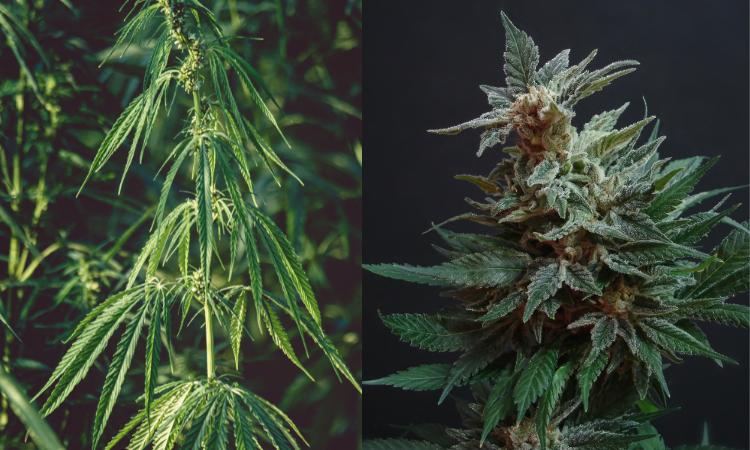The cannabis plant has been the subject of much discussion, regulation, and misunderstanding. At the heart of this confusion are two commonly conflated terms: hemp and marijuana. While both come from the same plant species, Cannabis sativa, they are distinct in their chemical composition, uses, and legal status. Clearing up these misconceptions is essential for consumers, farmers, and businesses to better understand the opportunities and regulations tied to each.
What Sets Hemp and Marijuana Apart?
The primary difference between hemp and marijuana lies in their chemical composition, specifically their levels of tetrahydrocannabinol (THC). THC is the psychoactive compound in cannabis responsible for the “high” associated with marijuana use. According to U.S. federal law, hemp must contain 0.3% THC or less on a dry weight basis. If a cannabis plant exceeds this THC threshold, it is legally classified as marijuana.
This distinction is critical for both cultivation and regulation. Hemp is grown primarily for industrial purposes, such as fiber, seeds, and cannabidiol (CBD) extraction. Marijuana, on the other hand, is cultivated for recreational and medicinal purposes due to its higher THC content.
Misconception 1: Hemp Can Get You High
One of the most common misconceptions is that hemp can produce a psychoactive high like marijuana. However, the extremely low THC levels in hemp make this impossible. Even if consumed in large amounts, hemp products—such as hemp oil or hemp seeds—lack the psychoactive properties that characterize marijuana. Hemp-derived CBD, which is nonintoxicating, is often used in wellness products for its potential benefits, such as reducing anxiety and inflammation.
Misconception 2: Marijuana and Hemp Are Grown the Same Way
The cultivation processes for hemp and marijuana differ significantly due to their end uses. Hemp is typically grown outdoors in large fields with minimal attention to individual plants. The goal is to maximize stalk and seed production for industrial applications like textiles, paper, and biofuels, or to cultivate CBD-rich flowers.
Marijuana, by contrast, is grown with meticulous care, often indoors, where factors like light, humidity, and temperature can be closely controlled. This ensures high THC potency and specific strain characteristics desired by recreational and medicinal users.
Misconception 3: Hemp Has No Economic Potential
Another misconception is that hemp has limited economic value compared to marijuana. In reality, hemp has been used for centuries in industries ranging from textiles to construction. Today, hemp’s versatility is creating exciting opportunities in emerging markets:
- Textiles and Clothing: Hemp fibers are durable, sustainable, and biodegradable, making
them an eco-friendly alternative to cotton. - Construction Materials: Hempcrete, made from hemp hurds and lime, is a lightweight,
insulating, and sustainable building material. - Nutrition: Hemp seeds are rich in protein, omega fatty acids, and essential nutrients,
finding their way into health foods and supplements. - CBD Market: Hemp is the primary source of CBD products, a booming industry projected
to reach $47 billion by 2028 (Grand View Research).
Farmers interested in diversification are increasingly drawn to hemp for its wide-ranging applications and growing consumer demand.
Misconception 4: Hemp and Marijuana Are Treated the Same Legally
Legally, hemp and marijuana occupy very different spaces. In the United States, the 2018 Farm Bill federally legalized the cultivation of hemp, allowing it to be grown, processed, and sold across the country. Marijuana, however, remains federally classified as a Schedule I controlled substance, although many states have legalized it for medicinal and recreational use.
This legal distinction has opened the door for hemp to re-emerge as a major agricultural crop, particularly as consumers and manufacturers seek sustainable materials and plantbased solutions. However, growers must remain vigilant, as hemp plants exceeding the 0.3% THC limit may be considered marijuana and must be destroyed under current laws.
Conclusion: A World of Opportunities
Understanding the differences between hemp and marijuana is essential for dispelling myths and unlocking the potential of each. Hemp stands out as a sustainable, versatile crop with applications spanning agriculture, health, and industry, while marijuana’s appeal lies in its medicinal and recreational value.
For farmers and businesses, the key to success lies in recognizing these distinctions and navigating the unique markets and regulations associated with each plant. Whether you’re cultivating hemp for CBD oil or marijuana for medicinal purposes, both offer distinct opportunities—and knowing the difference is the first step in seizing them.



